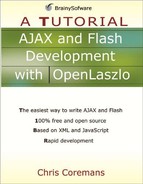Book Description
Introducing developers to OpenLaszlo—a new technology for developing Flash that is based on XML and JavaScript—this guide provides developers with all the information about this free and open-source tool, including how to code within the OpenLaszlo development environment and the OpenLaszlo development suite as it applies to rapid development time. How and why OpenLaszlo is used and supported by industry leaders such as IBM and Yahoo! is also discussed.
Book Description
Introducing developers to OpenLaszlo—a new technology for developing Flash that is based on XML and JavaScript—this guide provides developers with all the information about this free and open-source tool, including how to code within the OpenLaszlo development environment and the OpenLaszlo development suite as it applies to rapid development time. How and why OpenLaszlo is used and supported by industry leaders such as IBM and Yahoo! is also discussed.
Table of Contents
- Copyright
- Introduction
- Starting OpenLaszlo
- Basic Components
- Working with Text
- Layout Management
- Event Handling
- Constraints and States
- Animation
- Working with Data
- Working with Menus
- Custom Drawing
- Rich Components
- Extending Classes
- Communicating with the browser
- Debugging and Deployment
- Google Maps Application
- Introduction to XML
- Introduction to JavaScript
